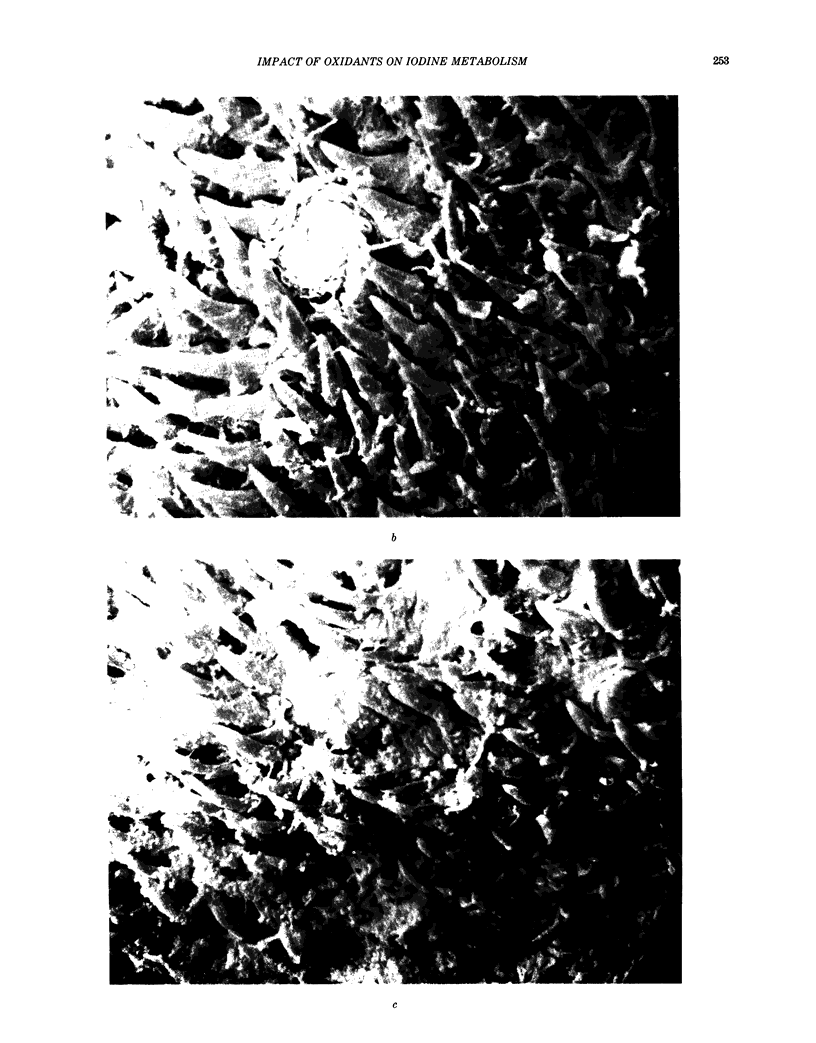Abstract
Toxicological studies dealing with recent findings of health effects of drinking water disinfectants are reviewed. Experiments with monkeys and rodents indicate that the biological activity of ingested disinfectants is expressed via their chemical interaction with the mucosal epithelia, secretory products, and nutritional contents of the alimentary tract. Evidence exists that a principal partner of this redox interaction is the iodide of nutritional origin that is ubiquitous in the gastrointestinal tract. Thus the observation that subchronic exposure to chlorine dioxide (ClO2) in drinking water decreases serum thyroxine levels in mammalian species can be best explained with changes produced in the chemical form of the bioavailable iodide. Ongoing and previously reported mechanistic studies indicate that oxidizing agents such as chlorine-based disinfectants oxidize the basal iodide content of the gastrointestinal tract. The resulting reactive iodine species readily attaches to organic matter by covalent bonding. Evidence suggests that the extent to which such iodinated organics are formed is proportional to the magnitude of the electromotive force and stoichiometry of the redox couple between iodide and the disinfectant. Because the extent of thyroid uptake of the bioavailable iodide does not decrease during ClO2 ingestion, it seems that ClO2 does not cause iodide deficiency of sufficient magnitude to account for the decrease in hormonogenesis. Absorption of one or more of iodinated molecules, e.g., nutrients, hormones, or cellular constituents of the alimentary tract having thyromimetic or thyroid inhibitory properties, is a better hypothesis for the effects seen.
Full text
PDF





Images in this article
Selected References
These references are in PubMed. This may not be the complete list of references from this article.
- Abdel-Rahman M. S., Couri D., Bull R. J. Kinetics of Cl02 and effects of Cl02, Cl02-, and Cl03- in drinking water on blood glutathione and hemolysis in rat and chicken. J Environ Pathol Toxicol. 1979 Dec;3(1-2):431–449. [PubMed] [Google Scholar]
- Abdel-Rahman M. S., Couri D., Bull R. J. Metabolism and pharmacokinetics of alternate drinking water disinfectants. Environ Health Perspect. 1982 Dec;46:19–23. doi: 10.1289/ehp.824619. [DOI] [PMC free article] [PubMed] [Google Scholar]
- Abdel-Rahman M. S., Couri D., Jones J. D. Chlorine dioxide metabolism in rat. J Environ Pathol Toxicol. 1979 Dec;3(1-2):421–430. [PubMed] [Google Scholar]
- Bercz J. P., Jones L., Garner L., Murray D., Ludwig D. A., Boston J. Subchronic toxicity of chlorine dioxide and related compounds in drinking water in the nonhuman primate. Environ Health Perspect. 1982 Dec;46:47–55. doi: 10.1289/ehp.824647. [DOI] [PMC free article] [PubMed] [Google Scholar]
- Chang Y. O. Effect of iodinated casein on production of vitamin B 12 and folic acid deficiency in rats. Am J Physiol. 1969 Jan;216(1):11–15. doi: 10.1152/ajplegacy.1969.216.1.11. [DOI] [PubMed] [Google Scholar]
- Couri D., Abdel-Rahman M. S., Bull R. J. Toxicological effects of chlorine dioxide, chlorite and chlorate. Environ Health Perspect. 1982 Dec;46:13–17. doi: 10.1289/ehp.824613. [DOI] [PMC free article] [PubMed] [Google Scholar]
- Harrington R. M., Shertzer H. G., Bercz J. P. Effects of ClO2 on the absorption and distribution of dietary iodide in the rat. Fundam Appl Toxicol. 1985 Aug;5(4):672–678. doi: 10.1016/0272-0590(85)90191-5. [DOI] [PubMed] [Google Scholar]
- Heffernan W. P., Guion C., Bull R. J. Oxidative damage to the erythrocyte induced by sodium chlorite, in vitro. J Environ Pathol Toxicol. 1979 Jul-Aug;2(6):1501–1510. [PubMed] [Google Scholar]
- Heffernan W. P., Guion C., Bull R. J. Oxidative damage to the erythrocyte induced by sodium chlorite, in vivo. J Environ Pathol Toxicol. 1979 Jul-Aug;2(6):1487–1499. [PubMed] [Google Scholar]
- Orme J., Taylor D. H., Laurie R. D., Bull R. J. Effects of chlorine dioxide on thyroid function in neonatal rats. J Toxicol Environ Health. 1985;15(2):315–322. doi: 10.1080/15287398509530657. [DOI] [PubMed] [Google Scholar]
- Turk J., Henderson W. R., Klebanoff S. J., Hubbard W. C. Iodination of arachidonic acid mediated by eosinophil peroxidase, myeloperoxidase and lactoperoxidase. Identification and comparison of products. Biochim Biophys Acta. 1983 Apr 13;751(2):189–200. doi: 10.1016/0005-2760(83)90173-x. [DOI] [PubMed] [Google Scholar]





